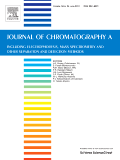
JOURNAL OF CHROMATOGRAPHY A
Scope & Guideline
Elevating Standards in Organic Chemistry Research
Introduction
Aims and Scopes
- Chromatographic Method Development:
Research often focuses on the optimization and development of new chromatographic methods, including high-performance liquid chromatography (HPLC), supercritical fluid chromatography (SFC), and capillary electrophoresis, aimed at improving separation efficiency and analytical sensitivity. - Application in Various Fields:
The journal covers diverse applications of chromatographic techniques in pharmaceuticals, environmental analysis, food safety, and biomolecular studies, showcasing how chromatography can be employed to solve real-world analytical challenges. - Innovative Analytical Techniques:
There is a consistent focus on the integration of chromatography with other techniques such as mass spectrometry (MS), nuclear magnetic resonance (NMR), and various spectroscopic methods to enhance analytical capabilities. - Sustainability and Green Chemistry:
Recent trends in the journal highlight the importance of sustainable practices in chromatography, including the development of green solvents and eco-friendly extraction techniques. - Computational and Theoretical Approaches:
The journal also emphasizes theoretical modeling and computational methods to predict retention behaviors, optimize chromatographic processes, and understand underlying mechanisms in separations.
Trending and Emerging
- Miniaturized and Portable Chromatography:
There is a growing trend towards the development of miniaturized and portable chromatographic systems, which allow for on-site analysis and enhance the accessibility of chromatographic techniques for field studies. - Integration of Machine Learning and AI:
The application of machine learning and artificial intelligence in chromatography is emerging, particularly for retention time prediction and method optimization, showcasing the intersection of computational science with traditional analytical techniques. - Focus on Biopharmaceuticals and Biological Samples:
Research related to the purification and analysis of biopharmaceuticals, including monoclonal antibodies and oligonucleotides, is increasingly prominent, reflecting the growing importance of biologics in medicine. - Sustainability and Green Analytical Chemistry:
A notable trend towards sustainable practices in chromatography, including the use of green solvents and eco-friendly extraction methods, is becoming more prevalent as environmental concerns shape research priorities. - Advanced Characterization Techniques:
There is an increasing emphasis on comprehensive analytical strategies that combine multiple techniques, such as two-dimensional liquid chromatography and integrated mass spectrometry, to achieve higher resolution and detailed profiling of complex samples.
Declining or Waning
- Traditional Chromatographic Techniques:
There appears to be a decline in publications focusing solely on traditional chromatographic techniques without integration with modern technologies, as researchers increasingly seek innovative approaches that combine multiple analytical methods. - Basic Method Validation Studies:
The frequency of basic method validation studies has decreased, possibly due to the growing expectation for more complex and nuanced validations that account for real-world variability and robustness. - Non-target Analysis in Environmental Samples:
Although still relevant, the emphasis on non-target analysis in environmental studies has shifted towards more targeted approaches, especially as regulatory frameworks evolve, leading to a decrease in purely exploratory studies. - Standard Operating Procedures (SOPs) for Chromatography:
There has been a noticeable decline in papers focused on SOPs as the field moves towards more innovative and flexible methodologies that prioritize adaptability and efficiency over rigid protocols.
Similar Journals
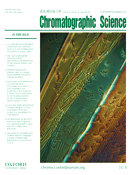
JOURNAL OF CHROMATOGRAPHIC SCIENCE
Elevating Understanding in Chromatographic ApplicationsWelcome to the Journal of Chromatographic Science, a premier publication dedicated to advancing the scientific understanding of chromatographic techniques and their applications across various disciplines. Published by Oxford University Press Inc, this journal, with its ISSN 0021-9665 and E-ISSN 1945-239X, has been disseminating innovative research since 1963, serving as a vital resource for researchers, industry professionals, and academic scholars in the fields of Analytical Chemistry and Medicine. As evidenced by its 2023 Scopus ranking, the journal stands at the Q3 quartile in both its primary disciplines, highlighting its relevance and contribution to ongoing research. The journal promotes high-quality, peer-reviewed articles that aim to foster knowledge and encourage the practical application of chromatographic science. While it operates under a traditional subscription model, the valuable insights it offers are essential for those seeking to enhance their expertise and stay at the forefront of chromatographic methodologies. Join our community of scholars as we explore the complexities and innovations in chromatographic science, paving the way for future discoveries.
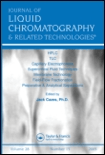
JOURNAL OF LIQUID CHROMATOGRAPHY & RELATED TECHNOLOGIES
Enhancing Knowledge in Pharmaceutical ScienceJOURNAL OF LIQUID CHROMATOGRAPHY & RELATED TECHNOLOGIES, published by Taylor & Francis Inc, is a pivotal platform for disseminating cutting-edge research in the field of liquid chromatography and its applications across various disciplines including analytical chemistry, biochemistry, and pharmaceutical science. With an ISSN of 1082-6076 and an E-ISSN of 1520-572X, this journal serves as an essential resource for researchers, professionals, and students committed to advancing the understanding and development of chromatographic techniques. Despite not being an open access publication, the journal features a robust submission process from 1996 to 2024, ensuring comprehensive coverage of historical and contemporary methodologies. Notably, it has achieved rankings in the Q3 and Q4 quartiles across various categories, reflecting its reputable position in the field. It’s recognized within key databases, with Scopus ranks indicating its influential role in areas such as pharmaceutical science and analytical chemistry. This journal is not only a cornerstone for specialized studies but also fosters interdisciplinary collaborations, making it an invaluable asset for the scientific community.

ANALYTICAL AND BIOANALYTICAL CHEMISTRY
Driving Excellence in Bioanalytical MethodologiesANALYTICAL AND BIOANALYTICAL CHEMISTRY, published by SPRINGER HEIDELBERG, is a leading international journal that serves as a vital platform for innovative research in the fields of analytical and bioanalytical chemistry. With an impressive impact factor and ranking in the Q2 category for both Analytical Chemistry and Biochemistry, the journal highlights key advancements and methodologies that drive the discipline forward. Established in 1996 and continuing vigorously into 2024, it has gained significant recognition with Scopus rankings placing it in the 83rd and 78th percentiles within its categories, underscoring its impact and relevance. The journal's commitment to open access facilitates widespread dissemination of critical scientific knowledge, making it an essential resource for researchers, professionals, and students dedicated to exploring the complexities of chemical analysis. With its base in Heidelberg, Germany, ANALYTICAL AND BIOANALYTICAL CHEMISTRY continues to inspire and influence the global research community.

Separations
Exploring New Horizons in Filtration and SeparationSeparations is a prestigious open-access journal published by MDPI, dedicated to advancing the fields of analytical chemistry and filtration and separation processes. Established in 2014, the journal has swiftly emerged as a significant platform for disseminating groundbreaking research and innovative methodologies in separation science, boasting an impressive E-ISSN of 2297-8739 and operating out of Basel, Switzerland. With its focus rotating from 2016 through 2024, Separations has been categorized in the Q3 quartile for both analytical chemistry and filtration and separation disciplines as of 2023, demonstrating its relevance in these scientific areas. The journal's rankings in Scopus, with 93rd out of 156 in analytical chemistry and 15th out of 19 in chemical engineering filtration and separation, reflect its commitment to high-quality research accessible to a global audience. Researchers, professionals, and students will find valuable insights and pioneering findings that foster collaboration and innovation within the vibrant community of separation science.

Chinese Journal of Chromatography
Illuminating the Path of Chemical Engineering and ElectrochemistryChinese Journal of Chromatography, published by SCIENCE PRESS, is a dedicated platform for disseminating pioneering research in the fields of Analytical Chemistry, Biochemistry, and Organic Chemistry. Established in 1997, this esteemed journal offers invaluable insights into chromatographic techniques and their applications, showcasing studies that contribute to the advancement of chemical engineering and electrochemistry. Although it currently holds a Q4 ranking in several categories, the journal aims to foster growth and knowledge among researchers, professionals, and students alike. With a continuous publication window extending until 2024, the Chinese Journal of Chromatography invites submissions that not only enhance scientific understanding but also address real-world challenges through innovative chromatographic solutions. Researchers looking for a collaborative community will find this journal a vital resource in their ongoing academic endeavors.
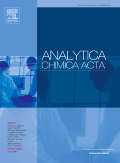
Analytica Chimica Acta
Pioneering insights in analytical and environmental chemistry.Analytica Chimica Acta is a prestigious peer-reviewed journal published by ELSEVIER, renowned for its significant contribution to the fields of analytical chemistry, biochemistry, environmental chemistry, and spectroscopy. Established in 1947, this journal has solidified its reputation, reflected in its impressive impact factors and Scopus rankings, including a Q1 classification in Analytical Chemistry and Spectroscopy, and a Q2 ranking in both Biochemistry and Environmental Chemistry. With its comprehensive scope, Analytica Chimica Acta aims to publish innovative research, critical reviews, and technical notes that advance the understanding and application of analytical methods. As an essential resource for researchers, professionals, and students alike, it encourages the dissemination of high-quality research that addresses contemporary challenges in chemical analysis and promotes interdisciplinary collaboration. While the journal operates primarily on a subscription basis, it also offers unique opportunities for authors to reach a broad audience and engage in the global scientific discourse.
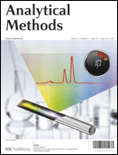
Analytical Methods
Unleashing Potential Through Analytical InnovationAnalytical Methods, published by the renowned Royal Society of Chemistry, is a distinguished journal that has been serving the scientific community since its inception in 2009. Specializing in the fields of Analytical Chemistry, Chemical Engineering, and General Engineering, this journal holds a reputable position with an impressive Q2 ranking in three relevant categories as of 2023. With its focus on innovative methodologies and advanced applications in analytical science, it aims to disseminate cutting-edge research and foster dialogue among researchers, professionals, and students. Although it is not an open access publication, it is accessible worldwide and provides critical insights into the latest developments in analytical techniques and their engineering applications. The journal also ranks highly in pertinent Scopus categories, such as being in the 77th percentile for General Engineering and 61st percentile for Analytical Chemistry, underlining its significance in advancing knowledge and practical applications in these fields. By participating in this journal, readers can expect to engage with high-quality research that influences the future of analytical practices and chemical engineering.

Journal of Analysis and Testing
Exploring the forefront of analytical methodologies.Journal of Analysis and Testing is a premier academic journal published by SPRINGER SINGAPORE PTE LTD, dedicated to advancing the fields of analytical and environmental chemistry. With ISSN 2096-241X and E-ISSN 2509-4696, the journal has established a significant presence since its inception in 2017, converging its focus until 2024. The journal's outstanding rankings in 2023, including Q1 quartile placements in Analytical Chemistry, Instrumentation, and Spectroscopy, underscore its pivotal role in disseminating high-quality research. Researchers can access cutting-edge studies that explore innovative testing methodologies, electrochemical analyses, and material evaluations, making it an essential resource for professionals and students alike. The Journal of Analysis and Testing not only celebrates advances in science and technology but also promotes interdisciplinary collaborations, ensuring widespread impact across analytical and environmental domains. As such, this journal plays a vital role in shaping the future of analytical practices and methodologies, positioning itself as a key conduit for knowledge exchange in the scholarly community.
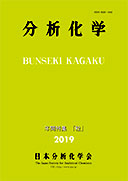
BUNSEKI KAGAKU
Fostering Innovation in Scientific InquiryBUNSEKI KAGAKU, published by the Japan Society Analytical Chemistry, is a reputable journal dedicated to the field of analytical chemistry. With an ISSN of 0525-1931, this journal has been a crucial outlet for scholarly communication since its inception in 1952, converging its publication years from 1954 to 1957 and from 1959 to 2024. Although it holds a Q4 category ranking in the most recent 2023 quartiles of analytical chemistry and ranks 153/156 in Scopus, it continues to serve as a platform for quality research, fostering advancements in the field. BUNSEKI KAGAKU is based in Tokyo, Japan, and emphasizes the critical importance of analytical techniques in scientific inquiry. With a commitment to professionalism and rigor, the journal provides a vital resource for researchers, students, and professionals seeking to explore innovative methodologies and contribute to the ongoing dialogue in analytical chemistry.
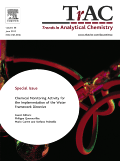
TRAC-TRENDS IN ANALYTICAL CHEMISTRY
Diving Deep into the Latest Methodologies and TechnologiesTRAC - Trends in Analytical Chemistry is a prestigious journal published by Elsevier Science Ltd, situated in the Netherlands. With an impressive impact factor reflected in its Q1 rankings across three major categories—Analytical Chemistry, Environmental Chemistry, and Spectroscopy—this journal stands at the forefront of disseminating pioneering research and advancements in the field of analytical chemistry. Established in 1981, TRAC provides a comprehensive platform for researchers to share influential studies and insights related to the latest trends, methodologies, and technologies in analytical techniques. Recognized globally, the journal excels in fostering cross-disciplinary dialogue and innovation, making it an indispensable resource for academics, professionals, and students alike. Explore the latest issues to stay abreast of cutting-edge developments that shape the analytical sciences.